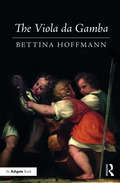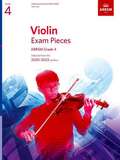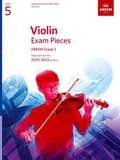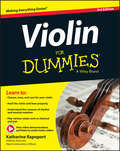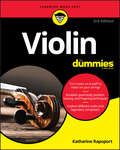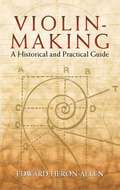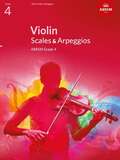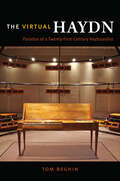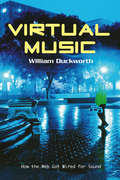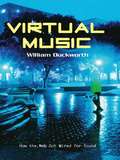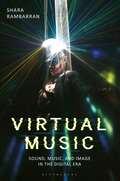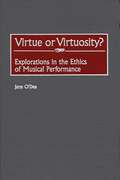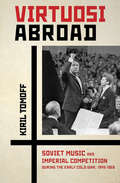- Table View
- List View
The Viola da Gamba
by Bettina HoffmannThe viola da gamba was a central instrument in European music from the late 15th century well into the late 18th. In this comprehensive study, Bettina Hoffmann offers both an introduction to the instrument -- its construction, technique and history -- for the non-specialist, interweaving this information with a wealth of original archival scholarship that experts will relish. The book begins with a description of the instrument, and here Hoffmann grapples with the complexity of various names applied to this and related instruments. Following two chapters on the instrument's construction and ancestry, the core of the book is given to a historical and geographical survey of the instrument from its origins into the classical period. The book closes with a look at the revival of interest in the 19th and 20th centuries.
The Viola da Gamba Society Index of Manuscripts Containing Consort Music: Volume II
by Robert ThompsonVolume II of The Viola da Gamba Society Index of Manuscripts Containing Consort Music includes manuscripts associated with John Browne (Clerk of the Parliaments), Philip Falle (prebendary at Durham), Sir Gabriel Roberts, John St Barbe of Broadlands, the Withy family of Worcester and Oxford and an anonymous late-seventeenth century scribe. As well as a detailed inventory of every manuscript (with anonymous works identified where possible), the descriptions include information on date, size, binding, paper, rastra, watermarks, collations, scripts, inscriptions and provenance, together with bibliographical references. Brief notes on the owners and copyists are provided. Of particular importance is the inclusion of facsimiles of all hands.
The Viola da Gamba Society Index of Manuscripts Containing Consort Music: Volume II
by Robert ThompsonVolume II of The Viola da Gamba Society Index of Manuscripts Containing Consort Music includes manuscripts associated with John Browne (Clerk of the Parliaments), Philip Falle (prebendary at Durham), Sir Gabriel Roberts, John St Barbe of Broadlands, the Withy family of Worcester and Oxford and an anonymous late-seventeenth century scribe. As well as a detailed inventory of every manuscript (with anonymous works identified where possible), the descriptions include information on date, size, binding, paper, rastra, watermarks, collations, scripts, inscriptions and provenance, together with bibliographical references. Brief notes on the owners and copyists are provided. Of particular importance is the inclusion of facsimiles of all hands.
Viola Scales & Arpeggios, ABRSM Grades 1–5: from 2012 (ABRSM Viola Scales & Arpeggios)
by AbrsmThis new edition contains all the scales and arpeggios required for ABRSM's Grades 1-5 Viola exams. Contains all scales and arpeggios for the revised syllabus from 2012, with bowing patterns and suggested fingering, and a helpful introduction including advice on preparing for the exam.
Viola Scales & Arpeggios, ABRSM Grades 1–5: from 2012 (ABRSM Viola Scales & Arpeggios)
by AbrsmThis new edition contains all the scales and arpeggios required for ABRSM's Grades 6-8 Viola exams. Contains all scales and arpeggios for the revised syllabus from 2012, with bowing patterns and suggested fingering, and a helpful introduction including advice on preparing for the exam.
Violin Exam Pieces 2020-2023, ABRSM Grade 4, Violin part
by AbrsmThis book contains nine pieces from ABRSM’s Grade 4 Violin syllabus for 2020–2023, three pieces chosen from each of Lists A, B and C. The pieces have been carefully selected to offer an attractive and varied range of styles, creating a collection that provides an excellent source of repertoire to suit every performer.
Violin Exam Pieces 2020-2023, ABRSM Grade 5: Selected from the 2020-2023 syllabus (ABRSM Violin Exam Pieces 2020-2023)
by AbrsmThis book contains nine pieces from ABRSM’s Grade 5 Violin syllabus for 2020–2023, three pieces chosen from each of Lists A, B and C. The pieces have been carefully selected to offer an attractive and varied range of styles, creating a collection that provides an excellent source of repertoire to suit every performer. The book also contains helpful footnotes and, for those preparing for exams, useful syllabus information. Inspiring recordings of the nine pieces featured in this book, plus piano accompaniment tracks, are available. These can be purchased as part of the "Violin Exam Pieces with CD" package or as audio downloads (see www.abrsmdownloads.org for more details).
Violin For Dummies
by Katharine RapoportThe beginner's guide to learning the violin — for any musical style Violin For Dummies helps you teach yourself to play the violin, even if you've never read a note of music. From choosing the right violin for you to playing a variety of musical styles, this book has you covered. You'll start with the basics of posture and bowing technique, learn how to tune your instrument and keep it in beautiful condition with regular maintenance. You'll learn how to read — and feel — the music, and how to inject your own personality into whatever you play. Before you know it, you'll be playing classical, jazz, country, and more, as you become a bona fide violin player. The included audio and video instruction encourages you to play along as you learn, and allow you to hear, see, and imitate proper technique. The violin's small size, portability, and mimicry of the human voice have made it popular across cultures and throughout time. This book shows you how to teach yourself the basics so you can start playing quickly. Start with the basics of proper hold and bowing technique Learn how to properly tune and care for your violin Understand the nuances of rhythm and musical notation Play classical, jazz, and other popular styles of music The violin has a reputation of being difficult to learn, but the reality is that it's difficult to master. Anyone can learn, and practice over time will refine your technique and your musical style. You'll have fun, make music, and maybe even fall in love with this instrument that has inspired some of the world's best musicians and composers. Get started today, the easy way, with Violin For Dummies.
Violin For Dummies
by Katharine RapoportThe beginner's guide to learning the violin — for any musical style Violin For Dummies helps you teach yourself to play the violin, even if you've never read a note of music. From choosing the right violin for you to playing a variety of musical styles, this book has you covered. You'll start with the basics of posture and bowing technique, learn how to tune your instrument and keep it in beautiful condition with regular maintenance. You'll learn how to read — and feel — the music, and how to inject your own personality into whatever you play. Before you know it, you'll be playing classical, jazz, country, and more, as you become a bona fide violin player. The included audio and video instruction encourages you to play along as you learn, and allow you to hear, see, and imitate proper technique. The violin's small size, portability, and mimicry of the human voice have made it popular across cultures and throughout time. This book shows you how to teach yourself the basics so you can start playing quickly. Start with the basics of proper hold and bowing technique Learn how to properly tune and care for your violin Understand the nuances of rhythm and musical notation Play classical, jazz, and other popular styles of music The violin has a reputation of being difficult to learn, but the reality is that it's difficult to master. Anyone can learn, and practice over time will refine your technique and your musical style. You'll have fun, make music, and maybe even fall in love with this instrument that has inspired some of the world's best musicians and composers. Get started today, the easy way, with Violin For Dummies.
Violin For Dummies: Book + Online Video and Audio Instruction
by Katharine RapoportTurn notes on a staff to notes on your strings Establish good body position, bowing, and fingering techniques Explore different styles and legendary composers Draw beautiful sounds from your violin! While learning the violin is a formidable goal, you don't have to be a music genius to grasp the basics. And with practice, the payoff will be music to your ears—plus a world of musical opportunity. This book starts you on the path to mastering the instrument that is central to musical cultures throughout the world. Playing along with the lessons in this friendly step-by-step guide will take you from first notes to performing entire songs—and you'll be glad you added this string to your bow! Inside... Choose your instrument Hold your violin correctly Play scales and chords Understand notation Master different music styles Tune and care for your instrument Find practice files online
Violin For Dummies: Book + Online Video and Audio Instruction
by Katharine RapoportTurn notes on a staff to notes on your strings Establish good body position, bowing, and fingering techniques Explore different styles and legendary composers Draw beautiful sounds from your violin! While learning the violin is a formidable goal, you don't have to be a music genius to grasp the basics. And with practice, the payoff will be music to your ears—plus a world of musical opportunity. This book starts you on the path to mastering the instrument that is central to musical cultures throughout the world. Playing along with the lessons in this friendly step-by-step guide will take you from first notes to performing entire songs—and you'll be glad you added this string to your bow! Inside... Choose your instrument Hold your violin correctly Play scales and chords Understand notation Master different music styles Tune and care for your instrument Find practice files online
Violin-Making: A Historical and Practical Guide
by Edward Heron-AllenThis classic guide offers an accessible initiation into the mysteries of violin-making. Charming in its style and cultivated in its research, it covers every detail of the process, from wood selection to varnish. A fascinating history of the instrument precedes discussions of materials and construction techniques. More than 200 diagrams, engravings, and photographs complement the text.Author Edward Heron-Allen served an apprenticeship with Georges Chanot, a preeminent nineteenth-century violin maker. The knowledge, skill, and experience Heron-Allen acquired in the master's shop are reflected in this book, which was the first to combine the history, theory, and practice of violin-making. Originally published in 1884 as Violin-Making, As It Was and Is: Being a Historical, Theoretical and Practical Treatise on the Science and Art of Violin-Making for the Use of Violin Makers and Players, Amateur and Professional, this volume has enlightened and informed generations of performers and players alike.
Violin Scales & Arpeggios, ABRSM Grade 4 (PDF): from 2012
by AbrsmThis edition contains all the scales and arpeggios required for ABRSM's Grade 4 Violin exam. Includes all Grade 4 scales and arpeggios for the revised syllabus from 2012, with bowing patterns and suggested fingering, along with a helpful introduction including advice on preparing for the exam.
The Virtual Haydn: Paradox of a Twenty-First-Century Keyboardist
by Tom BeghinHaydn’s music has been performed continuously for more than two hundred years. But what do we play, and what do we listen to, when it comes to Haydn? Can we still appreciate the rich rhetorical nuances of this music, which from its earliest days was meant to be played by professionals and amateurs alike? With The Virtual Haydn, Tom Beghin—himself a professional keyboard player—delves deeply into eighteenth-century history and musicology to help us hear a properly complex Haydn. Unusually for a scholarly work, the book is presented in the first person, as Beghin takes us on what is clearly a very personal journey into the past. When a discussion of a group of Viennese sonatas, for example, leads him into an analysis of the contemporary interest in physiognomy, Beghin applies what he learns about the role of facial expressions during his own performance of the music. Elsewhere, he analyzes gesture and gender, changes in keyboard technology, and the role of amateurs in eighteenth-century musical culture. The resulting book is itself a fascinating, bravura performance, one that partakes of eighteenth-century idiosyncrasy while drawing on a panoply of twenty-first-century knowledge.
The Virtual Haydn: Paradox of a Twenty-First-Century Keyboardist
by Tom BeghinHaydn’s music has been performed continuously for more than two hundred years. But what do we play, and what do we listen to, when it comes to Haydn? Can we still appreciate the rich rhetorical nuances of this music, which from its earliest days was meant to be played by professionals and amateurs alike? With The Virtual Haydn, Tom Beghin—himself a professional keyboard player—delves deeply into eighteenth-century history and musicology to help us hear a properly complex Haydn. Unusually for a scholarly work, the book is presented in the first person, as Beghin takes us on what is clearly a very personal journey into the past. When a discussion of a group of Viennese sonatas, for example, leads him into an analysis of the contemporary interest in physiognomy, Beghin applies what he learns about the role of facial expressions during his own performance of the music. Elsewhere, he analyzes gesture and gender, changes in keyboard technology, and the role of amateurs in eighteenth-century musical culture. The resulting book is itself a fascinating, bravura performance, one that partakes of eighteenth-century idiosyncrasy while drawing on a panoply of twenty-first-century knowledge.
The Virtual Haydn: Paradox of a Twenty-First-Century Keyboardist
by Tom BeghinHaydn’s music has been performed continuously for more than two hundred years. But what do we play, and what do we listen to, when it comes to Haydn? Can we still appreciate the rich rhetorical nuances of this music, which from its earliest days was meant to be played by professionals and amateurs alike? With The Virtual Haydn, Tom Beghin—himself a professional keyboard player—delves deeply into eighteenth-century history and musicology to help us hear a properly complex Haydn. Unusually for a scholarly work, the book is presented in the first person, as Beghin takes us on what is clearly a very personal journey into the past. When a discussion of a group of Viennese sonatas, for example, leads him into an analysis of the contemporary interest in physiognomy, Beghin applies what he learns about the role of facial expressions during his own performance of the music. Elsewhere, he analyzes gesture and gender, changes in keyboard technology, and the role of amateurs in eighteenth-century musical culture. The resulting book is itself a fascinating, bravura performance, one that partakes of eighteenth-century idiosyncrasy while drawing on a panoply of twenty-first-century knowledge.
The Virtual Haydn: Paradox of a Twenty-First-Century Keyboardist
by Tom BeghinHaydn’s music has been performed continuously for more than two hundred years. But what do we play, and what do we listen to, when it comes to Haydn? Can we still appreciate the rich rhetorical nuances of this music, which from its earliest days was meant to be played by professionals and amateurs alike? With The Virtual Haydn, Tom Beghin—himself a professional keyboard player—delves deeply into eighteenth-century history and musicology to help us hear a properly complex Haydn. Unusually for a scholarly work, the book is presented in the first person, as Beghin takes us on what is clearly a very personal journey into the past. When a discussion of a group of Viennese sonatas, for example, leads him into an analysis of the contemporary interest in physiognomy, Beghin applies what he learns about the role of facial expressions during his own performance of the music. Elsewhere, he analyzes gesture and gender, changes in keyboard technology, and the role of amateurs in eighteenth-century musical culture. The resulting book is itself a fascinating, bravura performance, one that partakes of eighteenth-century idiosyncrasy while drawing on a panoply of twenty-first-century knowledge.
Virtual Music: How the Web Got Wired for Sound
by William DuckworthVirtual Music: How the Web Got Wired for Sound is a personal story of how one composer has created new music on the web, a history of interactive music, and a guide for aspiring musicians who want to harness the new creative opportunities offered by web composing. Also includes a 4-page color insert.
Virtual Music: How the Web Got Wired for Sound
by William DuckworthVirtual Music: How the Web Got Wired for Sound is a personal story of how one composer has created new music on the web, a history of interactive music, and a guide for aspiring musicians who want to harness the new creative opportunities offered by web composing. Also includes a 4-page color insert.
Virtual Music: Sound, Music, and Image in the Digital Era
by Shara RambarranVirtuality has entered our lives making anything we desire possible. We are, as Gorillaz once sang, in an exciting age where 'the digital won't let [us] go…' Technology has revolutionized music, especially in the 21st century where the traditional rules and conventions of music creation, consumption, distribution, promotion, and performance have been erased and substituted with unthinkable and exciting methods in which absolutely anyone can explore, enjoy, and participate in creating and listening to music. Virtual Music explores the interactive relationship of sound, music, and image, and its users (creators/musicians/performers/audience/consumers). Areas involving the historical, technological, and creative practices of virtual music are surveyed including its connection with creators, musicians, performers, audience, and consumers. Shara Rambarran looks at the fascination and innovations surrounding virtual music, and illustrates key artists (such as Grace Jones, The Weeknd), creators (such as King Tubby, Kraftwerk, MadVillain, Danger Mouse), audiovisuals in video games and performances (such as Cuphead and Gorillaz), audiences, and consumers that contribute in making this musical experience a phenomenon. Whether it is interrogating the (un)realness of performers, modified identities of artists, technological manipulation of the Internet, music industry and music production, or accessible opportunities in creativity, the book offers a fresh understanding of virtual music and appeals to readers who have an interest in this digital revolution.
Virtual Music: Sound, Music, and Image in the Digital Era
by Shara RambarranVirtuality has entered our lives making anything we desire possible. We are, as Gorillaz once sang, in an exciting age where 'the digital won't let [us] go…' Technology has revolutionized music, especially in the 21st century where the traditional rules and conventions of music creation, consumption, distribution, promotion, and performance have been erased and substituted with unthinkable and exciting methods in which absolutely anyone can explore, enjoy, and participate in creating and listening to music. Virtual Music explores the interactive relationship of sound, music, and image, and its users (creators/musicians/performers/audience/consumers). Areas involving the historical, technological, and creative practices of virtual music are surveyed including its connection with creators, musicians, performers, audience, and consumers. Shara Rambarran looks at the fascination and innovations surrounding virtual music, and illustrates key artists (such as Grace Jones, The Weeknd), creators (such as King Tubby, Kraftwerk, MadVillain, Danger Mouse), audiovisuals in video games and performances (such as Cuphead and Gorillaz), audiences, and consumers that contribute in making this musical experience a phenomenon. Whether it is interrogating the (un)realness of performers, modified identities of artists, technological manipulation of the Internet, music industry and music production, or accessible opportunities in creativity, the book offers a fresh understanding of virtual music and appeals to readers who have an interest in this digital revolution.
Virtue or Virtuosity?: Explorations in the Ethics of Musical Performance (Contributions to the Study of Music and Dance)
by Jane O'DeaDrawing upon the past two decades of burgeoning literature in philosophy of music, this study offers a comprehensive, critical analysis of what is entailed in performance interpretation. It argues that integrity and other virtues offset the harm that virtuosity and rigid historical authenticity can impose on the perceptive judgment required of excellent musical interpretation. Proposed are challenging and provocative reassessments of the appropriate roles for virtuosity and historical authenticity in musical performance. Acknowledging the competitive ethos of the contemporary music scene, it details the kind of character a performer needs to develop in order to withstand those pressures and to achieve interpretive excellence. Performers are encouraged to examine and explore the ethical dimension of their art against their responsibilities to the diverse patrons they serve.Professional and student performers and instructors will appreciate this practical discussion of the ethical challenges performers confront when interpreting musical works. The ethical discourse applies to instrumental performance studies, the history and theory of music, general music pedagogy, and philosophy of music courses.
Virtuosi Abroad: Soviet Music and Imperial Competition during the Early Cold War, 1945–1958
by Kiril TomoffIn the 1940s and 1950s, Soviet musicians and ensembles were acclaimed across the globe. They toured the world, wowing critics and audiences, projecting an image of the USSR as a sophisticated promoter of cultural and artistic excellence. In Virtuosi Abroad, Kiril Tomoff focuses on music and the Soviet Union's star musicians to explore the dynamics of the cultural Cold War. He views the competition in the cultural sphere as part of the ongoing U.S. and Soviet efforts to integrate the rest of the world into their respective imperial projects. Tomoff argues that the spectacular Soviet successes in the system of international music competitions, taken together with the rapturous receptions accorded touring musicians, helped to persuade the Soviet leadership of the superiority of their system. This, combined with the historical triumphalism central to the Marxist-Leninist worldview, led to confidence that the USSR would be the inevitable winner in the global competition with the United States. Successes masked the fact that the very conditions that made them possible depended on a quiet process by which the USSR began to participate in an international legal and economic system dominated by the United States. Once the Soviet leadership transposed its talk of system superiority to the economic sphere, focusing in particular on consumer goods and popular culture, it had entered a competition that it could not win.
The Virtuoso Liszt (New Perspectives In Music History And Criticism Ser. #13 (PDF))
by Dana GooleyThe greatest virtuoso career in history - that of Franz Liszt - has been told in countless biographies. But what does that career look like when viewed from the perspective of European cultural history? In this study Dana Gooley examines the world of discussion, journalism, and controversy that surrounded the virtuoso Liszt, and reconstructs the multiple symbolic identities that he fulfilled for his enthusiastic audiences. Gooley's work is based on extensive research into contemporary periodicals - well-known and obscure journals and newspapers - as well as letters, memoirs, receipts and other documents that shed light on Liszt's concertising activities. Emphasising the virtuoso's contradictions, the author shows Liszt being constructed as a model aristocrat and a model bourgeois, as a German nationalist and a Hungarian nationalist, as a sensitive romantic artist and a military dictator, as a greedy entrepreneur and as a leading force for humanitarian charity.
